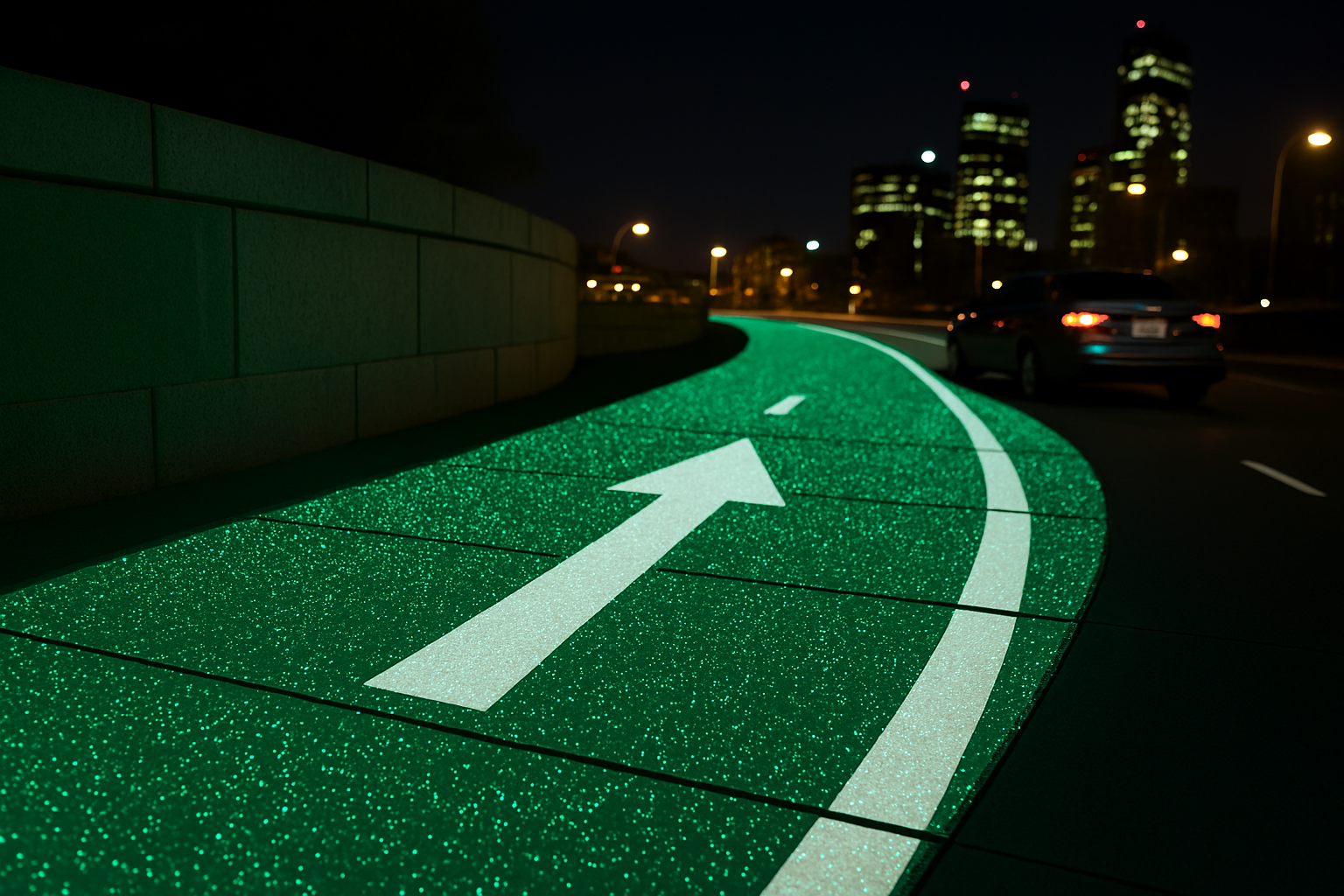Why glow-in-the-dark concrete is a material for the future
Concrete is the backbone of modern civilisation and is one of the most widely used man-made materials on Earth, but for all its strength and versatility, concrete has never been thought of as exciting. That perception is beginning to change. A new innovation - glow-in-the-dark concrete - promises not only to reshape the way we light our cities, but also to redefine how we think about infrastructure and sustainability.
What sounds like something from science fiction is, in fact, a real technology being tested and applied in projects around the world. By absorbing sunlight during the day and radiating a soft glow at night, this concrete has the potential to reduce energy consumption, enhance safety and create new opportunities for design. The story of glow-in-the-dark concrete is one of chemistry, engineering and imagination.
How glow-in-the-dark concrete works
At its core, glow-in-the-dark concrete is a modification of standard cement. The key lies in replacing or supplementing the ordinary fine particles of sand with phosphorescent materials. These are substances that absorb ultraviolet light from the sun during the day and release it gradually in the dark, producing a visible glow.
Phosphorescent compounds, such as aluminates doped with rare earth metals, are commonly used in glow-in-the-dark paints, toys and emergency signage. When embedded into the matrix of concrete, they provide the same effect but on a much larger and more durable scale.
Unlike traditional luminescent coatings that wear away, glow-in-the-dark concrete is created so that the glowing particles are integral to the material. This means the glow lasts as long as the concrete itself, which can be decades. Engineers have also found ways to control the brightness, colour and duration of the glow, with green and blue being the most effective for long-lasting illumination.
The concept of concrete that glows is relatively new. It was first brought into public discussion in the early 2010s, when researchers in Mexico and Europe began experimenting with cement formulations that could “store” sunlight. One of the most notable breakthroughs came from Dr. José Carlos Rubio of the Michoacán University of San Nicolás de Hidalgo in Mexico, who developed a patented process for phosphorescent cement.
Dr. Rubio’s version modified the microstructure of cement so that it could absorb light without the need for external phosphorescent additives. The result was a self-sustaining material that could glow for up to 12 hours after a day’s exposure to sunlight. His research highlighted a future in which roads, bike paths and buildings could light themselves naturally.
Since then, companies and design studios across the globe have taken the idea further, creating commercial products ranging from glowing concrete pavers for landscaping to large-scale installations in public infrastructure.
Practical applications of glow-in-the-dark concrete
The potential uses for glow-in-the-dark concrete are vast. By combining strength with illumination, it addresses two fundamental needs of urban life - durable infrastructure and safe, energy-efficient lighting.
Imagine a cycle path that glows softly at night, guiding riders without the need for streetlamps. This vision has already been realised in several European countries. In the Netherlands, the designer Daan Roosegaarde created a famous glow-in-the-dark bike path inspired by Van Gogh’s Starry Night. The path absorbs solar energy during the day and emits a magical, star-like glow at night, reducing reliance on artificial lighting.
Beyond the artistic effect, such paths can improve safety, particularly in rural areas where installing and powering street lighting is impractical.
Cities spend enormous amounts of money on street lighting. Glow-in-the-dark concrete could reduce some of that burden. While it cannot replace powerful lights needed in busy thoroughfares, it could supplement them on smaller roads, pavements, parks and pedestrian zones, cutting down electricity consumption and carbon emissions.
Architects are also beginning to see glow-in-the-dark concrete as a way to create dramatic façades and public spaces. A building wall that glows softly at night, or a plaza paved with glowing tiles, adds aesthetic value while also improving wayfinding and safety.
Related Read: How smart materials such as self-healing and thermochromic products are revolutionising construction.
Glowing pavers and stepping stones are already commercially available. Homeowners can use them to line paths, patios, or garden features, providing a practical light source without wiring or batteries.
Glow-in-the-dark concrete is not just visually striking; it is also part of the wider movement toward sustainable construction. Cities face mounting pressure to reduce their carbon footprints and lighting is a significant source of energy use. By passively providing light after sunset, glow-in-the-dark surfaces can cut energy demand.
The production process itself may also be more eco-friendly in some formulations. Researchers like Dr. Rubio have suggested that phosphorescent cement can be made with fewer of the polluting by-products normally associated with traditional cement manufacturing. This is a critical consideration, since cement production alone accounts for around 8% of global carbon dioxide emissions.
Furthermore, integrating lighting capacity into materials reduces the need for extra infrastructure such as lamp posts, cables, and maintenance systems. This means fewer resources used overall.
However, for all its promise, glow-in-the-dark concrete still faces hurdles before it becomes widespread. The glow is subtle compared to electric lighting. While it works well for guidance, pathways, and atmosphere, it cannot replace bright streetlamps in high-traffic zones. Engineers continue to refine the brightness and colour range, but current options are limited mostly to green and blue hues.
Glow-in-the-dark concrete is also more expensive to produce than traditional concrete, mainly due to the cost of phosphorescent materials or the modified cement process. However, advocates argue that long-term energy savings and reduced infrastructure costs offset the initial investment.
Furthermore, salt, pollution and constant wear can erode the glow effect over time. Protective surface treatments are often required to maintain performance, which adds another layer of complexity and cost.
The future of glow-in-the-dark concrete
Despite these challenges, the future looks bright - quite literally. Research continues into improving the longevity, brightness and colour palette of glow-in-the-dark concrete. Engineers are exploring hybrid systems that combine phosphorescent particles with solar micro-cells, creating materials that both store and generate light energy.
Cities experimenting with smart infrastructure are also interested in how glow-in-the-dark concrete might integrate with sensors, renewable power and autonomous transport. In the future, glowing roads may not only light themselves, but also communicate with vehicles and pedestrians.
In the architectural world, designers are increasingly looking for materials that combine functionality with beauty. Glow-in-the-dark concrete, with its ethereal nighttime presence, provides a new palette for creative expression. Whether used in parks, plazas, or entire building envelopes, it can transform urban environments.
Glow-in-the-dark concrete is still in its early stages, but its potential is undeniable. By merging two essential elements of modern life = infrastructure and illumination - it addresses practical needs while sparking the imagination. It offers safer paths, lower energy costs and more sustainable cities, all while reshaping the aesthetics of our built environment.
Like many great innovations, it began with a simple question - what if concrete could do more than just sit there? The answer is a material that charges by day and glows by night, pointing toward a future where our buildings and roads are not just functional, but alive with light.

Additional Blogs

How construction can cut Its carbon footprint by caring for soil
Soil is often dismissed as mere dirt, but it is one of the planet’s most powerful carbon stores, holding more than all of the world’s forests combined. Yet in our rush to build, pave and develop, we...
Read moreWhat is bridging damp? How it happens and how to fix it
Bridging damp happens when moisture finds a path around the building’s damp-proof course (DPC) so it reaches your internal walls and skirting. If you see damp patches rising above the skirting or...
Read more

The silent death of the fixed-price contract
For decades, the fixed-price contract has been the backbone of construction procurement. It promised certainty with a defined scope, an agreed sum and a clear transfer of risk from client to...
Read more